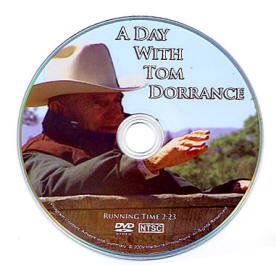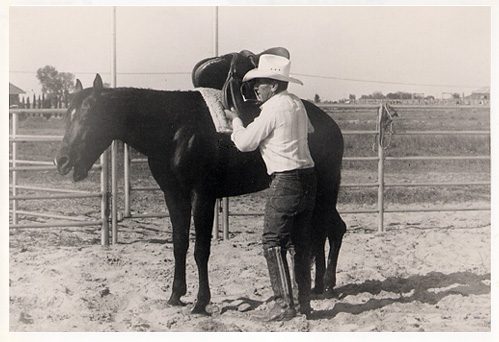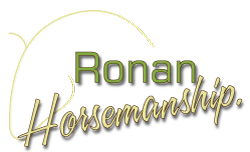
A Day With Tom Dorrance
A Day With Tom Dorrance is a DVD of almost unedited footage, two and a half hour spent with Tom Dorrance to discuss particular horse problems and see how he solves these issues.
It is commonly accepted that Tom Dorrance was one of the greatest horsemen, and reading his book True Unity is definitely a jewel in the mass of business books published every year.
Yet, I was not convinced by the DVD.
We can hear Tom Dorrance enunciate some of his principles as he is presented different horses having different horse problems. Seven horses are studied, from simple issues to more technical problems.
 Basic riding exercise
Basic riding exercise
The first horse is quite young and Tom Dorrance is asked to give general tips on how to ride it. This case is the opportunity to talk about timing: turning on time. The exercise is to ride without touching the reins, after a few steps simply lift the rein when the foot leaves the ground. Release as soon as the foot goes down. Repeat on both sides.
A Day With Tom Dorrance
This way of riding is used in order to build lightness, softness and to prevent any rodeo behavior.
 Doesn’t like to be cinched
Doesn’t like to be cinched
The second horse is just used to bite when cinched up and Tom Dorrance explains how you should block your horse with your elbow or your hand right before it starts to turn its head around to bite or push. Make it clear that such behavior is not acceptable.
 Doesn’t load into the trailer
Doesn’t load into the trailer
The third horse presents a common problem, that is to be scared to death to get into a trailer. Tom Dorrance uses the pressure and release principle to get the horse into the trailer. He actually uses food at the beginning and it is important to understand that food is used in order to get the horse relaxed. That is where the DVD could have been better: explanations! Seeing this video, at first sight we could actually think that Tom Dorrance simply proposes to lure a horse with food. That is quite short.

Later, Tom Dorrance and another man lay a rope on the ground, a third man leads the horse over that rope back to the trailer. The first two come from behind with the rope to put pressure on the horse’s hind end until it gets into the trailer. Then, it is time to teach the horse to get out of the trailer, backing up smoothly. Next, they repeat the loading in and out, but do no go away before loading it again, and again, and again.
I was actually disappointed by the process used here as we may not have two people and a ball of hay every time we want to load a horse. For this matter, Buck Brannaman’s short video about how to load a horse in a trailer is a lot more interesting and efficient on my mind.
 Doesn’t like to give the feet
Doesn’t like to give the feet
A Day With Tom Dorrance
 Doesn’t stand still when tied
Doesn’t stand still when tied
The fifth horse is reputed to bite the rope, kick the stall or trailer, etc. Tom Dorrance uses pebbles that he throws up above the level of the horse’s hip so it can see them falling down. That brings its attention to the pebbles instead of the trailer/stall where it is tied up as it will try to avoid them… That is a good illustration of how Tom Dorrance considers horses as individual minds, demanding reasoning and thinking to solve specific troubles.
 Doesn’t stay calm when getting into a crowded arena
Doesn’t stay calm when getting into a crowded arena
A Day With Tom Dorrance
 Doesn’t feel good with the bit
Doesn’t feel good with the bit
The seventh and last horse is busy with the bit, raising the head and clearly looking anxious. Lack of lightness prevents a horse to understand that you want to go to its legs when you make contact with its mouth. Pulling very lightly and waiting for a step or two will help to build lightness and softness.
As a conclusion, there are some interesting tips presented in this DVD but I think it can be watched only as an illustration of the book True Unity that contains all the knowledge distilled by Tom Dorrance.

 ENGLISH
ENGLISH DEUTSCH
DEUTSCH ESPAÑOL
ESPAÑOL FRANÇAIS
FRANÇAIS